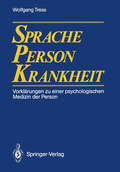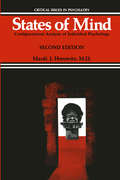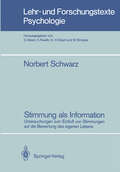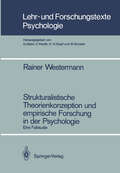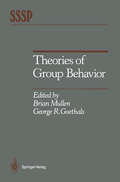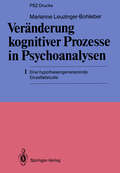- Table View
- List View
The Spontaneous Gesture: Selected Letters of D.W. Winnicott
by Donald W. Winnicott F. Robert RodmanThe collected letters of Donald Winnicott, a central figure in British psychoanalysis in the first post-Freud generation. They provide a vivid picture of Winnicott’s ideas and personality. Winnicott’s writings have become more and more influential over the years. His letters, published here, command immediate attention. Together with an insightful introduction by F. Robert Rodman, who sketches Winnicott’s life and traces the development of his ideas, they provide a vivid picture of the thought and personality of a man who has taught us much about our deepest selves.
Sprache — Person — Krankheit: Vorklärungen zu einer psychologischen Medizin der Person
by Wolfgang TressStates of Mind: Configurational Analysis of Individual Psychology (Critical Issues in Psychiatry)
by Mardi Jon HorowitzStimmung als Information: Untersuchungen zum Einfluß von Stimmungen auf die Bewertung des eigenen Lebens (Lehr- und Forschungstexte Psychologie #24)
by Norbert SchwarzDaß Stimmungsschwankungen die Beurteilungen des eigenen Lebens beeinflussen können, ist eine Alltagserfahrung. Eine fundierte Analyse zur Rolle emotionaler Zustände in der Urteilsbildung liegt jetzt vor: Der Autor hat verschiedene Ansätze zur Wechselwirkung von Emotion und Kognition gegenübergestellt und in Labor- sowie Feldexperimenten getestet. Die Befunde haben gezeigt, daß Personen bei der Beurteilung ihrer Lebenszufriedenheit ihre momentane Stimmung als Information berücksichtigen und in der gleichen Weise wie eine andere, externe Information verarbeiten. Aus diesem Ergebnis leitet sich ein theoretischer Ansatz für die Wechselwirkung von Kognition und Emotion ab, der die informative Funktion emotionaler Zustände hervorhebt und in die Entwicklung eines Urteilsmodells zum subjektiven Wohlbefinden eingeht. Dieser Band sollte in der Bibliothek von Psychologen, Soziologen und Meinungsforschern stehen.
Stress, Crowding, and Blood Pressure in Prison (Routledge Library Editions: Prison and Prisoners)
by Adrian M. Ostfeld Stanislav V. Kasl David A. D'Atri Edward F. FitzgeraldOriginally published in 1987, the purpose of Stress, Crowding, and Blood Pressure in Prison was to present, in a single location, the rationale, background, methods, principal results, analyses, interpretations, and conclusions of the authors’ studies at Massachusetts correctional institutions. Employing a longitudinal method for studying 568 inmates, the authors drew on psychological, social and health sciences assessments to identify the effects of housing mode, prison employment, leisure activities, disciplinary actions, and personal and sociodemographic characteristics to identify what was particularly stressful for inmates. A parallel study of prison staff and a specific series of conclusions and recommendations concludes the book.
Stress, Crowding, and Blood Pressure in Prison (Routledge Library Editions: Prison and Prisoners)
by Adrian M. Ostfeld Stanislav V. Kasl David A. D'Atri Edward F. FitzgeraldOriginally published in 1987, the purpose of Stress, Crowding, and Blood Pressure in Prison was to present, in a single location, the rationale, background, methods, principal results, analyses, interpretations, and conclusions of the authors’ studies at Massachusetts correctional institutions. Employing a longitudinal method for studying 568 inmates, the authors drew on psychological, social and health sciences assessments to identify the effects of housing mode, prison employment, leisure activities, disciplinary actions, and personal and sociodemographic characteristics to identify what was particularly stressful for inmates. A parallel study of prison staff and a specific series of conclusions and recommendations concludes the book.
Strukturalistische Theorienkonzeption und empirische Forschung in der Psychologie: Eine Fallstudie (Lehr- und Forschungstexte Psychologie #25)
by Rainer WestermannStrukturbildende Psychotherapie: Tiefenpsychologie und aktive Imagination
by W. KruckerDas vorliegende Buch beschreibt eine in dieser Form neue Methode der Psychotherapie. Mit Hilfe der "aktiven Imagination" als therapeutischer Technik wird ein Prozeß in Gang gesetzt, der eine Strukturveränderung bzw. den Aufbau neuer Strukturen in der Psyche des Klienten bewirken kann. Die im Bild erscheinenden Figuren/Gestalten und ihre Handlungen werden vom Unbewußten gesteuert - das bewußte Ich tritt mit ihnen in eine frei wählbare Beziehung. Der Therapeut beobachtet die Entwicklung der Handlung und greift nur ein, wenn das Ich eine Abwehrhaltung erkennen läßt. Der theoretische Verständnishintergrund geht dabei über die cartesianisch geprägte Metapsychologie Freuds hinaus und beschreibt die Doppelnatur des Menschen als Leibsein, ebenso wie als ungegenständliches In-der-Welt-Sein. Neuere Aspekte aus der Psychoanalyse werden im Hinblick auf die Strukturbildung zusammengefaßt. Diese Erkenntnisse fließen ein in eine Theorie einer phänomenologisch orientierten Psychotherapie. Indikation, Widerstand, Übertragung und Strukturaufbau werden beschrieben. Ein praktischer Teil illustriert die Schwierigkeiten und Besonderheiten der Imaginationstherapie mit Beispielen. Schlußendlich wird der Gesamtverlauf einer Therapie beschrieben.
The Synthesis of Self: Volume 1 the I of Consciousness Development from Birth to Maturity
by R. M. MendelsohnA psychoanalyst, through training and experience, directs the en tire focus of his attention to registering and internalizing the in put of a patient's communications, listening intently for their implied meanings. It is only by umaveling the mysteries of an un conscious realm of mental activity that it becomes possible to fully comprehend the way in which mental productions are finally ob servable. The psychoanalyst's total personality is the listening in strument, and the messages emanating from this hidden sector most clearly heard, deciphered, and understood are those most resonant with the contents of the psychoanalyst's unconscious. It is probable that a variety of psychoanalysts adopting a listening posture with a given patient would hear and understand a mul tiplicity of different meanings. Over the years, sensitive, well trained psychoanalytic investigators have formulated concepts con cerning mental functioning from disparate and often opposing points of view. These contradictory ideas are offered from a ba sic theoretical foundation placing unconscious mental events as the most important force shaping human experience. Divergent opin ions may at times appear irreconcilable and then serve as the grounds for developing a separate psychoanalytic school of thought. It is not surprising that an exploration of unseen powerful and regressive forces, by a group of scientists with unique in dividual experiences, would yield insights sensitively attuned to a wide variety of important factors determining human develop ment and behavior.
The Synthesis of Self: Volume 2 It All Depends on How You Look at It Development of Pathology in the Cohesive Disorders
by Lee S. CohenThe oedipal situation involves much more than an instinctual at titude toward a prohibited object giving expression to unconscious wishes. It introduces a whole new way of perceiving the internal and external world and an entirely different orientation to the myriad of life's experiences. A great deal of structural develop ment, requiring the negotiation of a sequence of early developmen tal tasks, has to have taken place before it is possible to encompass the complex demands of an oedipal attitude. When these early steps are not negotiated, although genital instinctual impulses may be manifested, the structural alignments necessary to enter into an oedipal position cannot be effected and the intrapsychic con flicts it engenders are not encountered. The thrust of early develop ment has made it essential for a narcissistic perspective to be adopted toward all stimuli and all relationships in order to enable All attachments must of necessity be continuing self-expansion. based upon the narcissistic supplies they contain, which ultimately lead to increasing levels of independence, self-differentiation, and individuation. It is precisely when the component instincts are con solidated into a genital drive that a narcissistic orientation can no longer incorporate the representation of experiences needed for the full realization of self-potentials. Were stimuli to only possess sig nificance in regard to their narcissistically enhancing attributes, the resulting dependence upon the external world would run counter to the thrust for independence and autonomy.
System Familie und Geistige Behinderung
by Maria T. SchubertDas Buch stellt neue wissenschaftliche Erkenntnisse der systemisch-strukturellen Familienforschung im Bereich der Behindertenarbeit vor. Es behandelt die Frage, ob bei Familien mit geistig behinderten Kindern vermehrt innerfamiliäre Schwierigkeiten, Dysfunktionalitäten und typische Fehlentwicklungen nachweisbar sind. Die Untersuchung wendet zwei, im deutschsprachigen Raum neue familiendiagnostische Instrumente an und vergleicht die Ergebnisse mit denen einer Kontrollgruppe sogenannter Normalfamilien. Ziel des Buches ist es, auf der Grundlage wissenschaftlich gesicherter Aussagen zu einem differenzierten Verständnis von Familien mit geistig behinderten Kindern beizutragen. Dem Wissenschaftler und Praktiker der Behindertenarbeit wird ein Modell über die Familienstruktur von Familien mit behinderten Kindern in die Hand gegeben, das er in Forschung und Praxis anwenden und validieren kann. System Familie und Geistige Behinderung, zwei aktuelle und vielbehandelte Themen, werden so in einer wissenschaftlichen Studie miteinander verknüpft.
System ohne Psyche: zur Kritik der Pragmatischen Kommunikationstheorie und ihrer Anwendungen (Beiträge zur psychologischen Forschung #11)
by Karl J. MeisterThe Theatre of the Dream (The New Library of Psychoanalysis)
by Salomon ResnikThe Theatre of the Dream is a profound study of our dream world and its place in everyday life. The author grounds his ideas in Freud and psychoanalysis authors such as Klein, Bion, Rosenfeld and Matte Blanco, but also draws on the approach to dream phenomena in the work of philosophers, artists and poets. He argues that dreams are indeed, as the ancients held, messages. The dream is a theatrical re-recreation of certain unconscious experiences, which are both subjective and objective at the same time. It expresses not only desire but a complex working over of a problematic situation that is not quite resolved. In waking the dream is a new elaboration of everyday experience and one which creates the seeds of oracular awareness. Resnik develops his thesis with ample and enlightening examples of dreams and their significance from his own patients. The author's achievement is a new psychoanalytic reading of dreams one which does justice to Freud's momentous discovery but which broadens it and places it within the wider context of subsequent developments in psychoanalysis, semiotics and social and cultural anthropology. The book will be of great value to the professional psychotherapist or psychoanalyst as well as to students of literature, the arts and linguistics and the wider public interested in the ongoing relationship between dream reality and what is commonly called external reality. As has been remarked, each era can be defined on the basis of relations between dream and life.
The Theatre of the Dream (The New Library of Psychoanalysis #Vol. 6)
by Salomon ResnikThe Theatre of the Dream is a profound study of our dream world and its place in everyday life. The author grounds his ideas in Freud and psychoanalysis authors such as Klein, Bion, Rosenfeld and Matte Blanco, but also draws on the approach to dream phenomena in the work of philosophers, artists and poets. He argues that dreams are indeed, as the ancients held, messages. The dream is a theatrical re-recreation of certain unconscious experiences, which are both subjective and objective at the same time. It expresses not only desire but a complex working over of a problematic situation that is not quite resolved. In waking the dream is a new elaboration of everyday experience and one which creates the seeds of oracular awareness. Resnik develops his thesis with ample and enlightening examples of dreams and their significance from his own patients. The author's achievement is a new psychoanalytic reading of dreams one which does justice to Freud's momentous discovery but which broadens it and places it within the wider context of subsequent developments in psychoanalysis, semiotics and social and cultural anthropology. The book will be of great value to the professional psychotherapist or psychoanalyst as well as to students of literature, the arts and linguistics and the wider public interested in the ongoing relationship between dream reality and what is commonly called external reality. As has been remarked, each era can be defined on the basis of relations between dream and life.
Theoretical Foundations of Behavior Therapy (Perspectives on Individual Differences)
by Michael Eysenck Irene Martin Hans J. EysenckIn this book we have attempted to confront a number of issues that are intimately related to the theoretical basis of behavior therapy. We believe that behavior therapy is an extremely efficient procedure for the treatment of neurotic disorders; that it is based on certain principles derived from learning theory; and that it is unique in using basic scientific principles in psychology in the service of applied and practical ends. We believe that we are here dealing with much more than the advantageous use of serendipitous borrowings from nonexistent principles, the cookbook collection of precepts, methods, and working rules that happen to have lasting effects. We also believe that there is truly a general principle unde. rlying behavior therapy, rather than a varied mass of nonintegrated therapies that have little in common other than a name. These beliefs are often contes ted, but usually those who oppose them do so on the basis of misconceptions and misunderstandings that indicate a lack of knowledge of fundamental facts. It is the purpose of this book to remove these misconceptions and misunderstandings, and to bring up to date our knowledge in certain fundamental areas of learning theory, behavior therapy, and the biological foundations of per sonality and individual differences. There are three major groups of misconceptions and misunderstandings. The first of these relates to beliefs held by many psychiatrists and cognitive psychologists relating to behavior therapy.
Theories of Group Behavior (Springer Series in Social Psychology)
by Lee S. CohenIn the fall of 1983, we began to organize a symposium entitled "General Social Psychological Theories of Group Behavior." Our goal was to encourage the extension and application of basic current social psychology to group behavior. The symposium was presented in the spring of 1984 at the Eastern Psychological Association convention in Baltimore and the interest that it generated led to discussions with colleagues and friends about similar efforts by social psychologists, eventually resulting in the present book. Some clarification about the contents is in order. First, the theories presented here are clearly social psychological in scope and level of analysis, as discussed in the Introduction (Chapter 1). However, we are not trying to encompass sociological, anthropological, political, or historical theoretical approaches to group behavior. Second, while the theories comprise a wide-ranging and representative, if not quite exhaustive, selection of social psychological theories of group behavior, there are some interesting and general perspectives that are not represented. For example, one perspective that is conspicuous by its absence is some variant of learning theory. Aside from the rare, notable exception (e.g., Buss, 1979), little work currently is being done on group behavior from a learning theoretic perspective. Our inclusion or exclusion of a theory reflects our judgment regarding its currency and accessibility to social psychological researchers.
Thinking: The Second International Conference
by D. N. Perkins J. Lochhead J. C. BishopFirst published in 1987. Routledge is an imprint of Taylor & Francis, an informa company.
Thinking: The Second International Conference
by D. N. Perkins, Jack Lochhead and John BishopFirst published in 1987. Routledge is an imprint of Taylor & Francis, an informa company.
Trauma, Growth and Personality
by Phyllis GreenacreThis collection of papers focuses on the interaction of maturation phases and special traumas in the first few years of life and the probable effect of these early patterns on the structure of the later personality.
Trauma, Growth and Personality (Maresfield Library)
by Phyllis GreenacreThis collection of papers focuses on the interaction of maturation phases and special traumas in the first few years of life and the probable effect of these early patterns on the structure of the later personality.
Veränderung kognitiver Prozesse in Psychoanalysen: 1 Eine hypothesengenerierende Einzelfallstudie (PSZ-Drucke)
by Marianne Leuzinger-BohleberViktor von Weizsäcker zum 100. Geburtstag: Beiträge zum Symposion der Universität Heidelberg (1.–3.5.1986) sowie der 24. Arbeitstagung des Deutschen Kollegiums für Psychosomatische Medizin (5. 3. 1986) und der 36. Lindauer Psychotherapiewochen (19. 4. 1986) (Schriften zur anthropologischen und interdisziplinären Forschung in der Medizin)
by P. Hahn W. JacobViruses, Immunity, and Mental Disorders
by Edouard Kurstak Z.J. Lipowski P.V. MorozovIn spite of progress in biomedical research, we know little about the causes, prevention, and treatment of the numerous mental and neurological disorders that afflict up to 15% of all individuals. In the last decade, great advances have been made in the physiopathology of mental and neurological disorders, leading to at least a partial control of Parkinson's disease, epilepsy, certain psychoses, and anxiety syndromes. Despite the fact that an underlying specific neurotransmitter deficiency has been demonstrated in Alzheimer's and Parkinson's diseases, the immune dysfunction and viral hypotheses continue to be attractive for investigators dealing with these degenerative diseases of the aging brain, which afflict 10% of senior citizens. A retrospective epidemiologic study suggests that the encephalitis lethargica and parkinsonism were almost certainly caused by the 1918 influenza virus pandemics. It must be stressed that the etiopathogenesis of many mental disorders is not known, and this ignorance has led to several untenable neurophysiological and biochemical hypotheses. Epidemiologic investigations show a high prevalence of functional psychoses and organic mental disorders. Although many of them are conceptualized as biopsychosocial disorders, recent data indicate that the biological component appears more and more as a major etiologic factor. Among the various biological hypotheses, the viral and im munologic concept has become a significant one. In view of recent discoveries in virology and immunity, it becomes clear that viral and immunologic hypotheses should be inves tigated more systematically concerning the mechanisms of numerous mental and neu rological disorders.
Visual Object Processing: A Cognitive Neuropsychological Approach (Psychology Library Editions: Perception #15)
by Glyn W. Humphreys M. Jane RiddochOriginally published in 1987, this book, attempted to bring together work by researchers concerned with the functional and neurological mechanisms underlying visual object processing, and the ways in which such mechanisms can be neurologically impaired. The editors termed it a ‘Cognitive Neuropsychological’ approach, because they believed it tried to relate evidence from neurological impairments of visual object processing to models of normal performance in a new and important way. Two broad aims are apparent. One is to test models of normal performance by evaluating how well the models account for the patterns of impairment and preservation of abilities that can occur following brain damage. The other is to use models of normal performance to further their understanding of acquired disorders of visual object processing. These aims distinguish the approach from neuropsychological work whose primary aim is to relate acquired deficits to the sites of damage, and from work in the field of cognitive psychology which attempts only to develop models of normal performance.

